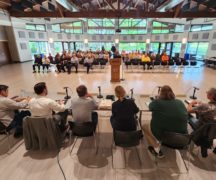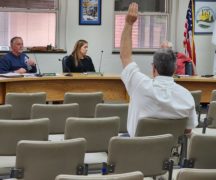By JAN LARSON McLAUGHLIN
BG Independent News
Pedestrians and bicyclists headed to City Park or the Slippery Elm Trail may soon be able to cross West Wooster Street without dodging traffic.
Bowling Green City Council heard the first reading, Monday evening, of an ordinance taking steps toward a pedestrian hybrid beacon crosswalk being installed near the intersection of Maple Street and West Wooster Street.
The ordinance authorizes the municipal administrator to sign an agreement with the Ohio Department of Transportation, seek qualifications, advertise for bids, and enter into contracts for design, engineering, right-of-way acquisition, construction and other services needed for the construction of the crosswalk.
The funding from ODOT is 90% of the total project cost, which is estimated around $200,000. Work may begin in the spring.
Accommodations were made during the current West Wooster Street project for this improvement, including placing conduit under the roadway.
The crosswalk will be similar to the two beacon crosswalks on East Wooster Street – one connecting with the Bowling Green State University campus between South College Drive and Troup Street, and the other near Panera and the Stroh Center at BGSU.
The crosswalks have buttons for pedestrians or bicyclists to press if they want to cross Wooster Street. The lights over Wooster will flash red first to alert traffic, then turn solid red, requiring traffic to wait while people cross the road.
These signaled crosswalks have provided a safe way for pedestrians to cross Wooster Street, according to the city.
The new crosswalk is part of the efforts of City Council and the Bicycle Safety Commission to improve pedestrian and bicycle safety throughout the community.
Maple Street has long been identified as a “strategic corridor” for bicyclists and pedestrians. The Bicycle Facilities and Destination Map, updated in February, identified Maple Street as a potential shared road corridor.
So the city applied for and received funding from the ODOT Safety Program for the installation of the pedestrian accommodation.
Maple Street has been on the top of the bicycle commission’s list for a long time for bicycle accommodations. In the past, city leaders have discussed the possibility of accommodations on the street, which connects City Park to the Slippery Elm Trail.
But the options were rejected. Sharrows, which are the decals on the street surface, in many cases would mean the removal of street parking. And bike lanes could require two-way streets to become one-way to allow for the dedicated bike lane.





